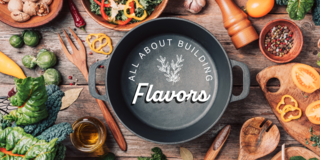All About Building Flavors

Building flavor isn't entirely about adding more ingredients to the dish. It's about understanding how ingredients work together and what different cooking techniques will do to your food. At its base, cooking can be defined as heating a food. That's it. There are so many interesting things that happen chemically to your food as you heat it though, and you have a lot of control over that process! Learning to build flavors is as complex and intimate as building a friendship. Each layer must be mastered before you can move onto the next, and when it's done you've become not only more familiar with the food, or friend, but also with yourself. Look at what you can do with just a little patience!
Understanding Flavor
When one begins to experiment with making better food, creating more nuanced flavors is often the first hurdle. Soup for example is technically just water, vegetables, noodles, and meat. Creating a truly satisfying soup requires building a good base of browned vegetables, combining with a flavorful broth, and then adding meat and more vegetables or pasta that may have already been cooked to enhance their flavors, too. You will often find that you can make food taste better just by cooking some of the water out of it, as is often the case with vegetables, while other foods need more time and spices to taste their absolute best. It's a joy to taste something truly good.
How to Make the Best Homemade Soup
Flavor Building Around the World
Building flavor is all about the base. For each cuisine, the base is a different combination of ingredients that's been influenced by hundreds of years' worth of influence on the cuisine. These bases can be built up from ingredients like vegetables, or with spices and seasonings. Understanding a culture's food choices comes from understanding their location, flavor preferences, and what spices and seasonings they are exposed to and eat most frequently. Building flavors for recipes in these cuisines requires a familiarity with their base ingredients, herbs, spices, and seasonings.
Asia
- Asian Spices and Seasonings
- Indian Spices and Seasonings
- Spices and Seasonings of Japan
- Middle Eastern Spices and Seasonings
- Spices and Seasonings of Vietnam
- Thai Spices and Seasoning Blends
Africa
North America
South America
Europe
Why People Eat the Way They Do
Our food preferences are no accident. As populations moved all over the world and trade routes were established, exposure to new foods increased for everyone. It used to be that you could only eat what you could grow, but thanks to modern technologies, we now have exposure to hundreds of flavors and ingredients that may not have been available even two hundred years ago. Recipes are often generational, following families for decades, resulting in food traditions that extend into new countries when people migrate. Think about Italian immigrants, whose food used to be associated with poor people and thought of as a lesser cuisine, to the Italian food of today that is celebrated and enjoyed across the United States. Something similar is currently happening with Chinese food, as we learn to appreciate a more authentic Chinese food experience and eat like people from China would eat. Today, we have a wider array of things to choose from, and yet we are still learning how to enjoy foods from other cultures and places on the globe.

